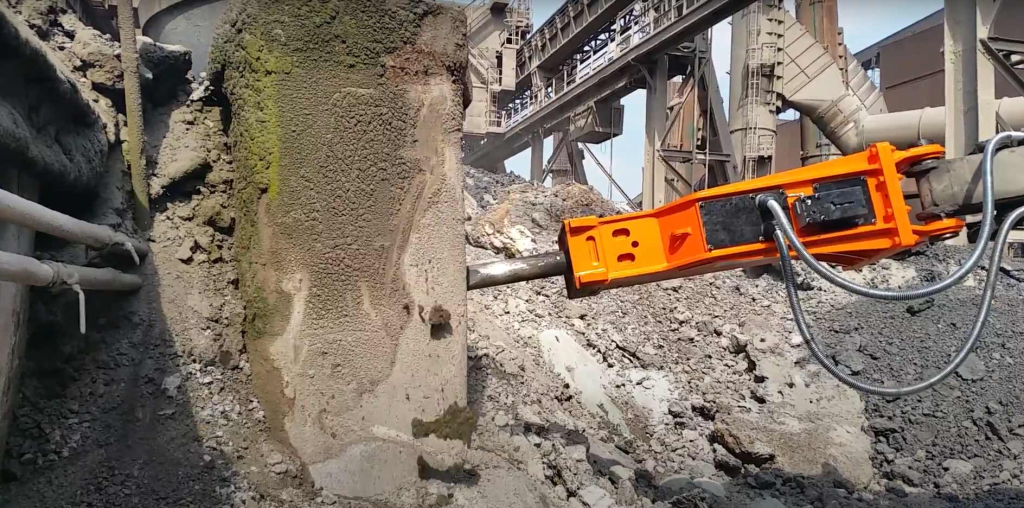
The earliest hydraulic attachments available are hydraulic hammers, which date back to 1967. Hydraulic breakers are another name for hydraulic hammers. Their primary purpose is to break through the substance, as suggested by their name. For tasks like rock excavation, asphalt cutting, demolition, and trenching, they are the ideal attachments. Hammer attachments have changed over time, leading to a wide range of different brands, models, sizes, and kinds on the market. You may learn everything there is to know about hydraulic hammers from today’s article.
How Are Excavator Hydraulic Hammers Built?
There are two types of hydraulic hammers, inner valve type, and outer valve type. The most crucial part of the hydraulic system is the cylinder. Both types of hydraulic hammers also have a piston. It converts kinetic energy into hammering energy.
Any proper excavator jack hammer has a fully enclosed cover, called housing. This cover protects the parts and ensures their prolonged durability. Apart from the hammer’s durability, the safety of the machine it is attached to is also of significant importance.
That is why many models also have shock absorbers, which protect the machine from impact. The shock absorber also constitutes protection. Many models also have a steel bushing in the bottom that protects the equipment from vibration.
This specific build and the mechanism of work make hydraulic breakers a popular choice for those who need equipment that provides less vibration and noise. They are also environmentally friendly because they produce less pollution.
How Do Hydraulic Breakers Work?
Hydraulic breakers use the principle of hydraulics in their work. The rule says that if the pressure is applied on one part of a fluid, that pressure is transferred to all areas of the fluid. As a result, the used force is multiplied. When this rule is applied to incompressible, the result is a transfer of power with a minimal loss.
Through the cylinder’s valve, oil is sent to the hammer. The main valve opens to discharge the pressure that builds up in the top chamber during an upward stroke. Conversely, the piston rises as a result of the lower chamber’s high pressure being released. After that, the piston descends and the upper chamber turns into the high-pressure one. Impact stroke alterations are the name given to these variations in pressure. They produce a great deal of energy, which is the same energy the tool needs to finish different demolition tasks.
Types of Hydraulic Hammers
To appropriately choose the right hammer for the demolition project it is necessary to understand the differences between the types. Thanks to that maximum efficiency and lowered operating costs can be achieved with every job. The main distinction between hydraulic hammers is their size:
1. Mini hammers – their working weights range between 400 and 1200 pounds. The design makes them perfect for minor and indoor projects. The small size also results in greater efficiency and easier operation than large models.
2. Medium hammers – these are the most popular hammer types, perfect for large concrete works, or utility projects. These hammers are very versatile due to their significant impact and efficiency. Medium-class hammers have working weights between 1900 and 3700 pounds.
3. Large hammers – they are characterized by high impact and less frequency than smaller hammers. Therefore, they are perfect for large excavation works and demolition projects. The working weight of this type of attachment range between 5000 and 7500 pounds.
Why Should You Get a Hydraulic Hammer?
You may wonder why a hydraulic breaker is so popular when there are many more hydraulic attachments on the market. Let us have a look at the most important benefits of hydraulic breakers:
1. Versatility – hydraulic hammers provide added flexibility and therefore flexibility to excavators, backhoe loaders, or skid-steer loaders.
2. Productivity – thanks to their power, hydraulic breakers decrease the amount of manual labor.
3. Traditional power attachments provide significantly less impact force than hydraulic parts.
4. Durability - among many benefits long service life is one of the biggest advantages of hydraulic hammers.
5. Efficiency – compared to air-powered models, hydraulic parts have improved efficiency thanks to fuel.
6. Fewer parts – there is no need for an air compressor or long hoses when using a hydraulic hammer.
7. Safety – there is significantly less noise and fewer accidents when using hydraulic hammers than manually operated ones.
Types of Excavator Attachments
- Hydraulic Scrap Magnet – Powerful electromagnet that can be mounted on the arm of an excavator or other machine
- Excavator Thumb – Grapple-like attachment for grabbing, lifting, and placing objects
- Compaction Wheel – Wheel-based attachment for soil and asphalt compaction
- Demolition Shear – Specialized jaws for cutting and crushing concrete, steel, and other debris
- Vibratory Plate Compactor – Attachment for compacting soil, gravel, and other granular materials
- Excavator Ripper – Toothed attachment for breaking up hard, compacted earth or rock
- Snow Plow – Blade attachment for clearing snow and ice from roads and job sites
- Excavator Grapple – Claw-like attachment for grabbing and lifting logs, debris, and other materials
- Excavator Tilt Rotator – Allows the excavator bucket or other attachment to rotate and tilt for precise positioning